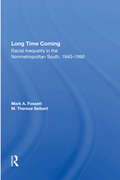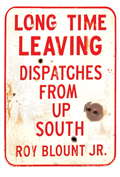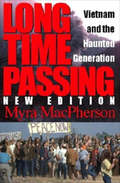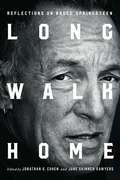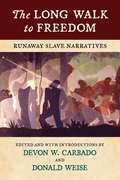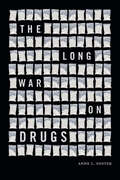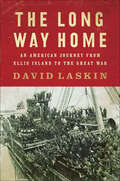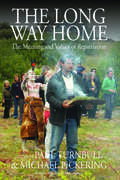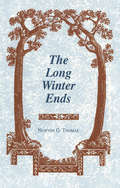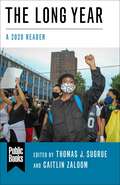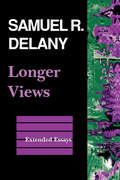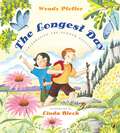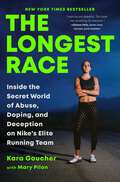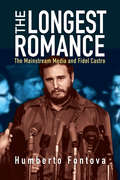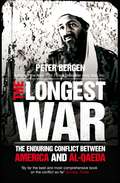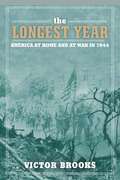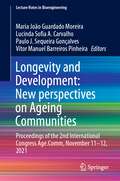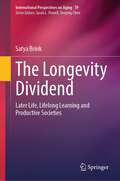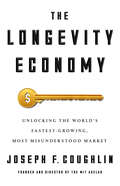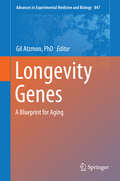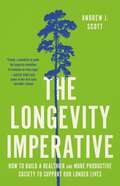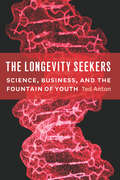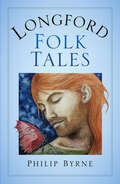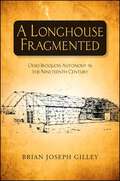- Table View
- List View
Long Time Coming: Racial Inequality In The Nonmetropolitan South, 1940-1990 (Rural Studies Series Of The Rural Sociological Society)
by Mark A Fossett Therese SeibertThe authors investigate trends in racial inequality in occupational attainment in rural areas of the South since 1940. Drawing on data from the six censuses spanning the last five decades, they examine how inequality varies across local areas and how it has changed over time in different local areas. While modest reductions in inequality have been observed in recent decades, the authors document that racial inequality in rural areas of the South persists at very high levels to the present day.Guided by structural-demographic theory, the authors investigate the connections between inequality and important changes taking place in the economic and social structures of rural communities of the South. They conclude that inequality is linked, sometimes in unexpected ways, with economic growth, urbanization and the decline of agricultural employment, the movement of women into the labor force, increasing minority educational attainment, and changes in racial demography. The authors investigate trends in racial inequality in occupational attainment in rural areas of the South since 1940. Drawing on data from the six censuses spanning the last five decades, they examine how inequality varies across local areas and how it has changed over time in different local areas. While modest reductions in inequality have been observed in recent decades, the authors document that racial inequality in rural areas of the South persists at very high levels to the present day.Guided by structural-demographic theory, the authors investigate the connections between inequality and important changes taking place in the economic and social structures of rural communities of the South. They conclude that inequality is linked, sometimes in unexpected ways, with economic growth, urbanization and the decline of agricultural employment, the movement of women into the labor force, increasing minority educational attainment, and changes in racial demography.
Long Time Leaving: Dispatches from Up South
by Roy Blount Jr.In this irreverent, eminently quotable book, Roy Blount Jr. focuses on his own dueling loyalties across the great American divide. Scholarly, biting, raunchy, and affable, Blount's musings may not end our Civil War, but they do clarify and aptly complicate divisive delusions on both sides of the longstanding national rift. A comic ode to American variety, Long Time Leaving is an assault on Northern and Southern complacency from one of the most celebrated essayists of our time.
Long Time Passing: Lives of Older Lesbians
by Marcy AdelmanWomen write about aging from their lesbian perspective.
Long Time Passing: Vietnam and the Haunted Generation
by Myra MacPhersonThis new edition of a classic book on the impact of the Vietnam War on Americans reintroduces the haunted voices of the Vietnam era to a new generation of readers. Based on more than 500 interviews, Long Time Passing is journalist Myra MacPherson&’s acclaimed exploration of the wounds, pride, and guilt of those who fought and those who refused to fight the war that continues to envelop the psyche of this nation. In a new introduction, Myra MacPherson reflects on what has changed, and what hasn&’t, in the years since these interviews were conducted, explains the key points of reference from the 1980s that feature prominently in them, and brings the stories of her principal characters up to date. &“A haunting chorus of voices, a moving deeply disturbing evocation of an era.&” —San Francisco Chronicle &“A brilliant and necessary book . . . this stunning depiction of Vietnam&’s bitter fruit is calculated to agitate even the most complacent American.&” —Philadelphia Inquirer &“There have been many books on the Vietnam War, but few have captured its second life as memory better than Long Time Passing.&” —Washington Post Book World &“Enthralling reading . . . full of deep and strong emotions.&” —New York Times
Long Walk Home: Reflections on Bruce Springsteen
by Natalie Adler Eric Alterman Regina Barreca Nancy Bishop Dermot Bolger Peter Ames Carlin Jefferson Cowie Jim Cullen Joel Dinerstein Gillian G. Gaar Martyn Joseph Deepa Iyer Greil Marcus Louis Masur Paul Muldoon Lauren Onkey Richard Russo A. O. Scott Colleen Sheehy Wesley Stace Frank Stefanko Irwin Streight Wayne Swan David L. Ulin Elijah Wald Daniel Wolff Kenneth WomackBruce Springsteen might be the quintessential American rock musician but his songs have resonated with fans from all walks of life and from all over the world. This unique collection features reflections from a diverse array of writers who explain what Springsteen means to them and describe how they have been moved, shaped, and challenged by his music. Contributors to Long Walk Home include novelists like Richard Russo, rock critics like Greil Marcus and Gillian Gaar, and other noted Springsteen scholars and fans such as A. O. Scott, Peter Ames Carlin, and Paul Muldoon. They reveal how Springsteen’s albums served as the soundtrack to their lives while also exploring the meaning of his music and the lessons it offers its listeners. The stories in this collection range from the tale of how “Growin’ Up” helped a lonely Indian girl adjust to life in the American South to the saga of a group of young Australians who turned to Born to Run to cope with their country’s 1975 constitutional crisis. These essays examine the big questions at the heart of Springsteen’s music, demonstrating the ways his songs have resonated for millions of listeners for nearly five decades. Commemorating the Boss’s seventieth birthday, Long Walk Home explores Springsteen’s legacy and provides a stirring set of testimonials that illustrate why his music matters.
The Long Walk to Freedom: Runaway Slave Narratives
by Donald Weise Devon W. CarbadoIn this groundbreaking compilation of first-person accounts of the runaway slave phenomenon, editors Devon Carbado and Donald Weise have recovered twelve narratives spanning eight decades--more than half of which have been long out of print. Told in the voices of the runaway slaves themselves, these narratives reveal the extraordinary and often innovative ways that these men and women sought freedom and demanded citizenship.
The Long War on Drugs
by Anne L. FosterSince the early twentieth century, the United States has led a global prohibition effort against certain drugs in which production restriction and criminalization are emphasized over prevention and treatment as means to reduce problematic usage. This “war on drugs” is widely seen to have failed, and periodically decriminalization and legalization movements arise. Debates continue over whether the problems of addiction and crime associated with illicit use of drugs stem from their illegal status or the nature of the drugs themselves. In The Long War on Drugs Anne L. Foster explores the origin of the punitive approach to drugs and its continued appeal despite its obvious flaws. She provides a comprehensive overview, focusing not only on a political history of policy developments but also on changes in medical practices and understanding of drugs. Foster also outlines the social and cultural changes prompting different attitudes about drugs; the racial, environmental, and social justice implications of particular drug policies; and the international consequences of US drug policy.
The Long Way Home: An American Journey from Ellis Island to the Great War
by David Laskin“Moving, revealing, and lovingly researched, this book is a must read, and a great read, for any of us whose forebears came from overseas—meaning just about all of us.” — Erik LarsonThe author of the award-winning The Children’s Blizzard, David Laskin, returns with a remarkable true story of the immigrants who risked their lives fighting for America during the Great War.In The Long Way Home, award-winning writer David Laskin traces the lives of a dozen men who left their childhood homes in Europe, journeyed through Ellis Island, and started over in a strange land—only to cross the Atlantic again in uniform when their adopted country entered the Great War.Though they had known little of America outside of tight-knit ghettos and backbreaking labor, these foreign-born conscripts were rapidly transformed into soldiers, American soldiers, in the ordeal of war. Two of the men in this book won the Medal of Honor. Three died in combat. Those who survived were profoundly altered–and their heroic service reshaped their families and ultimately the nation itself.Epic, inspiring, and masterfully written, this book is an unforgettable true story of the Great War, the world it remade, and the humble, loyal men who became Americans by fighting for America.
The Long Way Home
by Michael Pickering Paul TurnbullIndigenous peoples have long sought the return of ancestral human remains and associated artifacts from western museums and scientific institutions. Since the late 1970s their efforts have led museum curators and researchers to re-evaluate their practices and policies in respect to the scientific uses of human remains. New partnerships have been established between cultural and scientific institutions and indigenous communities. Human remains and culturally significant objects have been returned to the care of indigenous communities, although the fate of bones and burial artifacts in numerous collections remains unresolved and, in some instances, the subject of controversy. In this book, leading researchers from a wide range of disciplines in the humanities and social sciences reflect critically on the historical, cultural, ethical and scientific dimensions of repatriation. Through various case studies they consider the impact of repatriation: what have been the benefits, and in what ways has repatriation given rise to new problems for indigenous people, scientists and museum personnel. It features chapters by indigenous knowledge custodians, who reflect upon recent debates and interaction between indigenous people and researchers in disciplines with direct interests in the continued scientific preservation of human remains. In this book, leading researchers from a wide range of disciplines in the humanities and social sciences reflect critically on the historical, cultural, ethical and scientific dimensions of repatriation. Through various case studies they consider the impact of repatriation: what have been the benefits, and in what ways has repatriation given rise to new problems for indigenous people, scientists and museum personnel. It features chapters by indigenous knowledge custodians, who reflect upon recent debates and interaction between indigenous people and researchers in disciplines with direct interests in the continued scientific preservation of human remains.
The Long Winter Ends: Long Winter Ends
by Newton G. ThomasThe Long Winter Ends tells the story of a year in the life of a young emigrant miner who leaves Cornwall in the southwest of England to work in the copper mines of Michigan's Upper Peninsula.
The Long Year: A 2020 Reader (Public Books Series)
by Andy Horowitz Éric Charmes Max Rousseau Adam Tooze Joan Wallach Scott Andrew Lakoff Keisha N. Blain Natalia Molina Marcia Chatelain Michelle Cera Gilles Guiheux Ye Guo Renyou Hou Manon Laurent Jun Li Anne-Valérie Ruinet Govindan Venkatasubramanian Isabelle Guérin Mathieu Ferry Marine Al Dahdah Neha Vora Sulfikar Amir Sherihan Radi Mustafa Dikeç Keeanga-Yamahtta Taylor Simon Balto Jeffrey Aaron Snyder Rachel Nolan David Schmidt Julie Livingston Margaret Morganroth Gullette Xiaowei Wang Priscilla Wald Evan Lieberman Warwick Anderson Julia Foulkes Soledad Álvarez Velasco Sophie Lewis Guobin Yang Sophie Gonick Margaret O'Mara Alfonso Fierro Erick Corrêa Ananya Roy Gianpaolo Biaocchi Jake Carlson Quentin Ravelli Jean-Paul Gagnon Rikki J. Dean Afsoun Afsahi Emily Beausoleil Selen A. Ercan Miguel Centeno Gautam Bhan Joanne Randa Nucho Yarimar Bonilla Jacob A.C. Remes Warren Breckman Cordula Dittmer Daniel F. Lorenz Kathryn Cai Eric Klinenberg David S. Barnes Kavita Sivaramakrishnan Merlin ChowkwanyunSome years—1789, 1929, 1989—change the world suddenly. Or do they? In 2020, a pandemic converged with an economic collapse, inequalities exploded, and institutions weakened. Yet these crises sprang not from new risks but from known dangers. The world—like many patients—met 2020 with a host of preexisting conditions, which together tilted the odds toward disaster. Perhaps 2020 wasn’t the year the world changed; perhaps it was simply the moment the world finally understood its deadly diagnosis.In The Long Year, some of the world’s most incisive thinkers excavate 2020’s buried crises, revealing how they must be confronted in order to achieve a more equal future. Keeanga-Yamahtta Taylor calls for the defunding of police and the refunding of communities; Keisha Blain demonstrates why the battle against racism must be global; and Adam Tooze reveals that COVID-19 hit hardest where inequality was already greatest and welfare states weakest. Yarimar Bonilla, Xiaowei Wang, Simon Balto, Marcia Chatelain, Gautam Bhan, Ananya Roy, and others offer insights from the factory farms of China to the elite resorts of France, the meatpacking plants of the Midwest to the overcrowded hospitals of India.The definitive guide to these ongoing catastrophes, The Long Year shows that only by exposing the roots and ramifications of 2020 can another such breakdown be prevented. It is made possible through institutional partnerships with Public Books and the Social Science Research Council.
Longer Views: Extended Essays
by Samuel R. Delany Ken James"Reading is a many-layered process -- like writing," observes Samuel R. Delany, a Nebula and Hugo award-winning author and a major commentator on American literature and culture. In this collection of six extended essays, Delany challenges what he calls "the hard-edged boundaries of meaning" by going beyond the customary limits of the genre in which he's writing. By radically reworking the essay form, Delany can explore and express the many layers of his thinking about the nature of art, the workings of language, and the injustices and ironies of social, political, and sexual marginalization. Thus Delany connects, in sometimes unexpected ways, topics as diverse as the origins of modern theater, the context of lesbian and gay scholarship, the theories of cyborgs, how metaphors mean, and the narrative structures in the Star Wars trilogy."Over the course of his career," Kenneth James writes in his extensive introduction, "Delany has again and again thrown into question the world-models that all too many of us unknowingly live by." Indeed, Delany challenges an impressive list of world-models here, including High and Low Art, sanity and madness, mathematical logic and the mechanics of mythmaking, the distribution of wealth in our society, and the limitations of our sexual vocabulary. Also included are two essays that illustrate Delany's unique chrestomathic technique, the grouping of textual fragments whose associative interrelationships a reader must actively trace to read them as a resonant argument. Whether writing about Wagner or Hart Crane, Foucault or Robert Mapplethorpe, Delany combines a fierce and often piercing vision with a powerful honesty that beckons us to share in the perspective of these Longer Views.
The Longest Day: Celebrating the Summer Solstice
by Wendy PfefferIn this fourth and final book in the series about seasons, Wendy Pfeffer turns her attention to summer, when butterflies emerge from silky cocoons and daylight hours stretch longer and longer. With lyrical prose and vibrant illustrations, The Longest Day takes us on a journey through the history and science behind the summer solstice, with a focus on summer celebrations from various cultures around the world. Teachers and students alike will treasure the varied and accessible knowledge, and activities in the back let everyone in on the festivities.
The Longest Race: Inside the Secret World of Abuse, Doping, and Deception on Nike's Elite Running Team
by Kara GoucherIn this unvarnished and affecting memoir, Olympian Kara Goucher reveals her experience of living through and speaking out about one of the biggest scandals in running. <p><p>Kara Goucher grew up with Olympic dreams. She excelled at running from a young age and was offered a Nike sponsorship deal when she graduated from college. Then in 2004, she was invited to join a secretive, lavishly funded new team, dubbed the Nike Oregon Project. <p><p>Coached by distance running legend Alberto Salazar, it seemed like the opportunity of a lifetime. Kara was soon winning a World Championship medal, going to the Olympics, and standing on the podium at the New York and Boston marathons, just like her coach. But behind the scenes, Salazar was hiding dark secrets. He pushed the limits of anti-doping rules, and created what Kara experienced as a culture of abuse, the extent of which she reveals in her book for the first time. Meanwhile, Nike stood by Alberto for years and proved itself capable of shockingly misogynistic corporate practices. <p><p>Told with stunning honesty, The Longest Race is an unforgettable story and a call to action. Kara became a crusader for female athletes and a key witness helping to get Salazar banned from coaching at the Olympic level. Kara’s memoir reveals how she broke through the fear of losing everything, bucked powerful forces to take control of her life and career, and reclaimed her love of running. <p> <b>New York Times Bestseller</b>
The Longest Romance
by Humberto FontovaFidel Castro jailed political prisoners at a higher rate than Stalin during the Great Terror. He murdered more Cubans in his first three years in power than Hitler murdered Germans during his first six. Alone among world leaders, Castro came to within inches of igniting a global nuclear holocaust.But you would never guess any of that from reading the mainstream American media. Instead we hear fawning accounts of Castro liberating Cuba from the clutches of U.S. robber-barons and bestowing world-class healthcare and education on his downtrodden citizens. "Propaganda is vital-the heart of our struggle," Castro wrote in 1955. Today, the concept is as valid to the Cuban regime as ever.History records few propaganda campaigns as phenomenally successful or enduring as Castro and Che's. The Longest Romance exposes the full scope of this deception; it documents the complicity of major U.S. media players in spreading Castro's propaganda and in coloring the world's view of his totalitarian regime. Castro's cachet as a celebrity icon of anti-Americanism has always overshadowed his record as a warmonger, racist, sexist, Stalinist, and godfather of modern terrorism. The Longest Romance uncovers this shameful history and names its major accomplices.
The Longest War: The Enduring Conflict Between America and al-Qaeda
by Peter BergenIn The Longest War Peter Bergen offers a comprehensive history of the war on terror and its evolution, from the strategies devised in the wake of the 9/11 attacks to the fighting in Afghanistan, Pakistan, and beyond. Unlike any other book on this subject, Bergen tells the story of this shifting war's failures and successes from both the perspective of the United States and al-Qaeda and its allies. He goes into the homes of al-Qaeda members, rooting into the source of their devotion to terrorist causes, and he spends time in the offices of the major players shaping the U. S. strategic efforts in the region. At a time when many are frustrated or fatigued with what has become an enduring multigenerational conflict, this book will provide an illuminating narrative that not only traces the arc of the fight, but projects its likely future. At a critical moment in world history The Longest War provides the definitive account of the ongoing battle against terror.
The Longest Year: America at War and at Home in 1944
by Victor BrooksThe D-Day invasion of Nazi-occupied Europe, launched on June 6, 1944, is widely referred to as the longest day of World War Two. Historian Victor Brooks argues that 1944 was, in effect, "the longest year” for Americans of that era, both in terms of United States casualties and in deciding the outcome of war itself. Brooks also argues that only the particular war events of 1944 could have produced the "reshuffling” of the cards of life that, in essence, changed the rules for most of the 140 million Americans in some fashion. Rather than focusing on military battles and strategy alone, the author chronicles the year as a microcosm of disparate military, political, and civilian events that came together to define a specific moment in time. As war was raging in Europe, Americans on the home front continued to cope (with some prospering). As U. S. forces launched an offensive against the Japanese in the Mariana Islands and Palau, folks at home enjoyed morale-boosting movies and songs such as To Have and Have Not and "G. I. Jive. ” And as American troops invaded the island of Leyte--launching the largest naval battle during the war--President Franklin D. Roosevelt and Thomas E. Dewey were in the home stretch leading up to the election of 1944. It has been said that the arc of history is long. Throughout American history, however, some years have been truly momentous. This book makes the case that 1944 was one such year. Skyhorse Publishing, as well as our Arcade imprint, are proud to publish a broad range of books for readers interested in history--books about World War II, the Third Reich, Hitler and his henchmen, the JFK assassination, conspiracies, the American Civil War, the American Revolution, gladiators, Vikings, ancient Rome, medieval times, the old West, and much more. While not every title we publish becomes a New York Times bestseller or a national bestseller, we are committed to books on subjects that are sometimes overlooked and to authors whose work might not otherwise find a home.
Longevity and Development: Proceedings of the 2nd International Congress Age.Comm, November 11–12, 2021 (Lecture Notes in Bioengineering)
by Maria João Guardado Moreira Lucinda Sofia A. Carvalho Paulo J. Sequeira Gonçalves Vítor Manuel Barreiros PinheiraThis book focuses on the dynamic process of aging and on interventions to support the development of older and integrated societies, from a multidisciplinary point of view. Gathering contributions from researchers and professionals with different backgrounds, including social and health sciences, education, engineering and IT, biology, geography and environmental science, it aims at understanding the phenomenon of population aging, in order to contribute to the development of future functional communities, fostering well-being and autonomy of the elderly, their integration and participation. Based on the proceedings of the 2nd International Congress Age.Comm Longevity and Development, organised online on November 11-12, 2021, from Castelo Branco, Portugal, this book addresses a wide range of specialists dealing with the process of aging, integration and community development in the societies of the future.
The Longevity Dividend: Later Life, Lifelong Learning and Productive Societies (International Perspectives on Aging #39)
by Satya BrinkThis book offers global evidence about the increasing longevity, its consequences and its potential for societal benefits. Based on statistics, academic literature, policy initiatives and numerous country experiences, it explains the interconnected effects of a longer later life, lifelong learning and more productive societies. This larger picture shows how the future can be managed by making strategic choices today. Choosing the right policies allows gaining the maximum benefits from the longevity dividend for current and future generations. This book explains how investing in lifelong learning can enrich the longevity dividend. It gives valuable insights for policy advisors, decision makers, researchers, health professionals, practitioners, students of aging and late life educators.
The Longevity Economy: Unlocking the World's Fastest-Growing, Most Misunderstood Market
by Joseph F. CoughlinOldness: a social construct at odds with reality that constrains how we live after middle age and stifles business thinking on how to best serve a group of consumers, workers, and innovators that is growing larger and wealthier with every passing day.Over the past two decades, Joseph F. Coughlin has been busting myths about aging with groundbreaking multidisciplinary research into what older people actually want--not what conventional wisdom suggests they need. In The Longevity Economy, Coughlin provides the framing and insight business leaders need to serve the growing older market: a vast, diverse group of consumers representing every possible level of health and wealth, worth about $8 trillion in the United States alone and climbing.Coughlin provides deep insight into a population that consistently defies expectations: people who, through their continued personal and professional ambition, desire for experience, and quest for self-actualization, are building a striking, unheralded vision of longer life that very few in business fully understand. His focus on women--they outnumber men, control household spending and finances, and are leading the charge toward tomorrow's creative new narrative of later life--is especially illuminating.Coughlin pinpoints the gap between myth and reality and then shows businesses how to bridge it. As the demographics of global aging transform and accelerate, it is now critical to build a new understanding of the shifting physiological, cognitive, social, family, and psychological realities of the longevity economy.
Longevity Genes
by Gil AtzmonThe release of the complete version of the human genome sequence in 2003 has paved the way for defining gene function and genetic background for phenotypic variation in humans and allowed us to study the aging process in a new light. This new volume results from that research and focuses on the genetic and epigenetic process of aging. While the interpretation of the genome data is still in its initial stages, this new volume looks at the evolving understanding of molecular mechanisms involved in cellular processes, gene function associated with complex traits, epigenetic components involve in gene control and the creation of hypothesis-free genome-wide approaches. Longevity Genes: A Blueprint for Aging explores the genetic and genomic elements that can maintain a long life such as DNA damage mechanisms, epigenetics and the way we can use this knowledge to generate customized treatments. It touches on some of the multidisciplinary approaches as well as genomic-wide association technology used to analyze complex traits. This book describes the hunt for genes affecting complex traits using a high throughput technology, with adequate consideration for the selection of an appropriate population, applications of statistical genetics and computational biology, and most importantly, considering phenotype-genotype association studies. Longevity Genes provides coverage of not only established aspects of genetics and aging, but also new approaches and perceptions in this important area of research.
The Longevity Imperative: How to Build a Healthier and More Productive Society to Support Our Longer Lives
by Andrew J. Scott&“A manifesto to guide the longevity revolution&” (David Sinclair) for individuals, institutions, and society to adapt to the reality of living longer lives Thanks to increases in life expectancy, we can now expect to live for a long time. Most of us would welcome an extra day in the week, so why do so many of us view the prospect of additional years with fear and skepticism? The reason is simple: society is not currently structured to support long lives. Rather than thinking in terms of the needs of a rising number of older people, we must instead support the young and middle-aged to prepare differently for the longer futures they can expect. The Longevity Imperative outlines the innovations needed to make the most of these longer lives: substantial changes to our health system, economy, and financial sector, as well as in how we manage our careers, health, finances, and relationships. Instead of seeing longevity as a problem, economist Andrew J. Scott challenges us to view it as an opportunity. This book charts a course to address the individual, social, political, economic, and cultural changes required so that all of us—regardless of age—can live lives that are not just longer but healthier, happier, and more productive.
The Longevity Seekers: Science, Business, and the Fountain of Youth (From Obscurity, 1980-2005 -- Greater Than The Double Helix Itself, 1980-1990 -- The Grim Reaper, 1991-1993 -- Sorcerer's Apprentices, 1991-1996 -- Race For A Master Switch, 1989-2000 -- Money To Burn, 2000-2003 -- Longevity Noir, 2003-2004 -- Betting The Trifecta, 2005-2006 -- Defying Gravity: The Battle To Find A Drug For Extending Health, 2005-2013 -- Sex, Power And The Wild: The Evolution Of A)
by Ted Anton&“[A] beautifully told story of twenty-first-century researchers in pursuit of the secrets of longevity . . . a book both engaging and illuminating.&” —Deborah Blum, Pulitzer Prize-winning author People have searched for the fountain of youth everywhere from Bimini to St. Augustine. But for a steadfast group of scientists, the secret to a long life lies elsewhere: in the lowly lab worm. By suppressing the function of just a few key genes, these scientists were able to lengthen worms&’ lifespans up to tenfold, while also controlling the onset of many of the physical problems that beset old age. As the global population ages, the potential impact of this discovery on society is vast—as is the potential for profit. With The Longevity Seekers, science writer Ted Anton takes readers inside this tale that began with worms and branched out to snare innovative minds from California to Crete, investments from big biotech, and endorsements from TV personalities like Oprah and Dr. Oz. Some of the research was remarkable, such as the discovery of an enzyme in humans that stops cells from aging. And some—like an oft-cited study touting the compound resveratrol, found in red wine—proved highly controversial, igniting a science war over truth, credit, and potential profit. As the pace of discovery accelerated, so too did powerful personal rivalries and public fascination, driven by the hope that a longer, healthier life was right around the corner. Anton has spent years interviewing and working with the scientists at the frontier of longevity science, and this book offers a behind-the-scenes look at the state-of-the-art research and the impact it might have on global public health, society, and even our friends and family
Longford Folk Tales
by Philip ByrneLongford Folk Tales is a treasure trove of wonderful stories of saints and deities, fairies and devils, kings and ghosts, shoemakers and other engaging characters. Read about The Blake Millions, butter stealing, the Wooing of Étaín, and ‘The Walking Gallows’, Hempenstall – all your favourite legends and many more.This selection of tales and stories from every corner of the county of Longford reflects the wisdom of the countryside and its people. Legends, folk customs and local lore from earliest times up to the county’s more recent past are expertly told by storyteller Philip Byrne.
A Longhouse Fragmented: Ohio Iroquois Autonomy in the Nineteenth Century
by Brian Joseph GilleyA Longhouse Fragmented is a historic ethnography of the Ohio Iroquois and, in particular, of the people known as the Seneca of Sandusky during the early nineteenth century. Using contemporary social theory and interdisciplinary methodologies, Brian Joseph Gilley tells the social history of the Native peoples of Ohio before and during the sociopolitical buildup to removal. As culturally, geographically, and socially displaced Iroquois, the Sandusky Iroquois were fragmented away from American historiographical constructions of Iroquois social history by the American Indian academic establishment. This fragmentation makes the early cultural history of the Ohio Iroquois an ideal foil through which to consider how normalized interpretations of social history come to appear real and have real effects for the subject societies well into the twentieth century. These stories are intended to begin an overdue conversation about the effects of a unified Iroquois history congealed around highly specific categories of knowledge.
